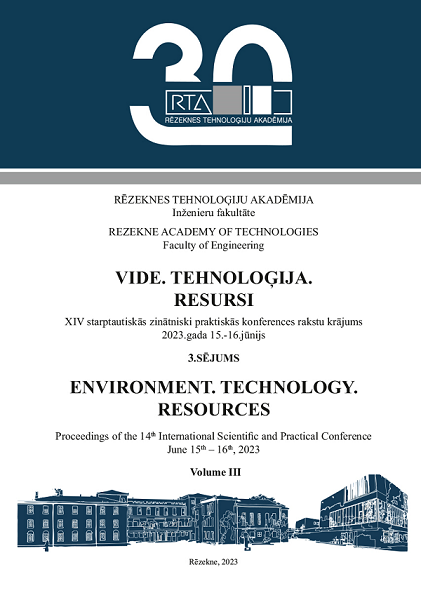INVESTIGATING THE CONTRAST OF SURFACE MARKING ON DIFFERENT COLOR CONNECTORS FOR TELECOMMUNICATIONS NEEDS
DOI:
https://doi.org/10.17770/etr2023vol3.7263Keywords:
ABS plastic, Contrast, Fiber laser marking, QR code, RoughnessAbstract
The development of marking technologies for telecommunications connectors requires increasingly detailed information about their applications. One solution is to use QR codes that contain sufficient information about the connectors' applications. Accurate marking of connectors requires a precise marking system, such as a laser marking system. In this study, a Rofin PowerLine F20 Varia fiber laser was used to mark four different types of ABS plastic connectors in various colors. To achieve optimal marking for all four colors, three experiments were conducted to achieve contrasting marking and high roughness. Easy QR code reading was achieved with an average marking power of 3 W to 4.2 W, a laser marking speed of 300 mm/s to 500 mm/s, and a scanning frequency of 50 kHz to 70 kHz at a constant pulse duration of 8 ns and raster spacing of 50 µm. The microstructural changes and change in roughness were determined using a laser scanning microscope (Olympus OLS5000), which revealed structural changes on the surface and an increase in relative roughness from 39% to 76%. This experiment shows that different parameters of the laser marking mode are required for each color.References
F. Bravo-Montero, D. Castells-Rufas and J. Carrabina, High-speed laser marking with diode arrays, Optics & Laser Technology, Volume 146, 2022, https://doi.org/10.1016/j.optlastec.2021.107551.
C. Lin, X. Shen, B. Hua and Z. Wang, Three-dimensional polarization marked multiple-QR code encryption by optimizing a single vectorial beam, Optics Communications, Volume 352, pp. 25-32, 2015, https://doi.org/10.1016/j.optcom.2015.04.068.
R. Kikuchi, S. Yoshikawa, P. K. Jayaraman, J. Zheng and T. Maekawa, Embedding QR codes onto B-spline surfaces for 3D printing, Computer-Aided Design, Volume 102, pp. 215-223, 2018, https://doi.org/10.1016/j.cad.2018.04.025.
В. И. Семашко, МЕТОДЫ ЛАЗЕРНОЙ МАРКИРОВКИ, Докады - БГУИР, Минск, Беларусь 2004. [Online]. Available: https://cyberleninka.ru/article/n/metody-lazernoy-markirovki/viewer [Accessed May 1, 2023].
J. C. Ion, Chapter 15, Laser Processing of Engineering Materials, Butterworth-Heinemann, 2005, pp. 384-394.
E. Hadizadeh, S. Pazokifard, S.M. Mirabedini and H. Ashrafian, Optimizing practical properties of MMA-based cold plastic road marking paints using mixture experimental design, Progress in Organic Coatings, Volume 147, 2020, https://doi.org/10.1016/j.porgcoat.2020.105784.
Y. M. Noor, S. C. Tam, L. E. N. Lim and S. Jana, A review of the Nd: YAG laser marking of plastic and ceramic IC packages, Journal of Materials Processing Technology, Volume 42, Issue 1, Pages 95-133, 1994, https://doi.org/10.1016/0924-0136(94)90078-7.
P. Narica and J. Fedotovs, Laser Marking of a Small Sized QR Code on a Plastic Surface, Reliability and Statistics in Transportation and Communication, vol 117, pp 418–429, Springer, March 2020, https://doi.org/10.1007/978-3-030-44610-9_41.
M. A. Salim, Z. H. Termiti and A. Md. Saad, Mechanical Properties on ABS/PLA Materials for Geospatial Imaging Printed Product using 3D Printer Technology, Reference Module in Materials Science and Materials Engineering, Elsevier, 2019, https://doi.org/10.1016/B978-0-12-803581-8.11357-8.
S. R. Sabreen, “Basic Material Science for Plastics Laser Marking” The Sabreen Group, Inc. January 2009, https://plasticsdecorating.com/articles/2009/basic-material-science-for-plastics-laser-marking/ [Accessed May 1, 2023].
R. L. Stevenson, Implementation of Beam-Steered Laser Marking of Coated and Uncoated Plastics, Coloring Technology for Plastics, pp. 309-315, 1999, https://doi.org/10.1016/B978-188420778-5.50040-1.
“Fiber laser”, FiberLabs Inc., July 2021, https://www.fiberlabs.com/glossary/fiber-laser/ [Accessed May 1, 2023].
N. Angelov, Investigation the Influence of the Number of Repetition and Volumetric Energy Density on Laser Marking of Products, Contemporary Materials, V−2, pp. 251-253, 2014, DOI:10.7251/COMEN1402250A
S. Olivera, H. B. Muralidhara, K.Venkatesh, et al., Plating on acrylonitrile–butadiene–styrene (ABS) plastic: a review. J Mater, vol 51, pp. 3657–3674, January 2016, https://doi.org/10.1007/s10853-015-9668-7.
C. Lavieja, M. J. Clemente, L. Oriol and J. I. Peña, Influence of the Wavelength on Laser Marking on ABS Filled with Carbon Black, Polymer-Plastics Technology and Engineering, pp. 1599-1607, Apr 2017, https://doi.org/10.1080/03602559.2017.1280735.
C. Guo and S. C. Singh, Handbook of Laser Technology and Applications: Lasers Applications: Materials Processing and Spectroscopy, Volume 3, 2nd ed., p. 360, CRC Press, June 2021, https://doi.org/10.1201/9781315310855.
Engraving lasers Rofin, Home page, [Online]. Available: https://graviranje.rs/Engraving_PORTAL/lasers/rofin/Rofin_PowerLine_F20.html [Accessed May 1, 2023].
Olympus Global Homepage, [Online]. Available: https://www.olympus-global.com/news/2017/nr00633.html [Accessed May 1, 2023].



